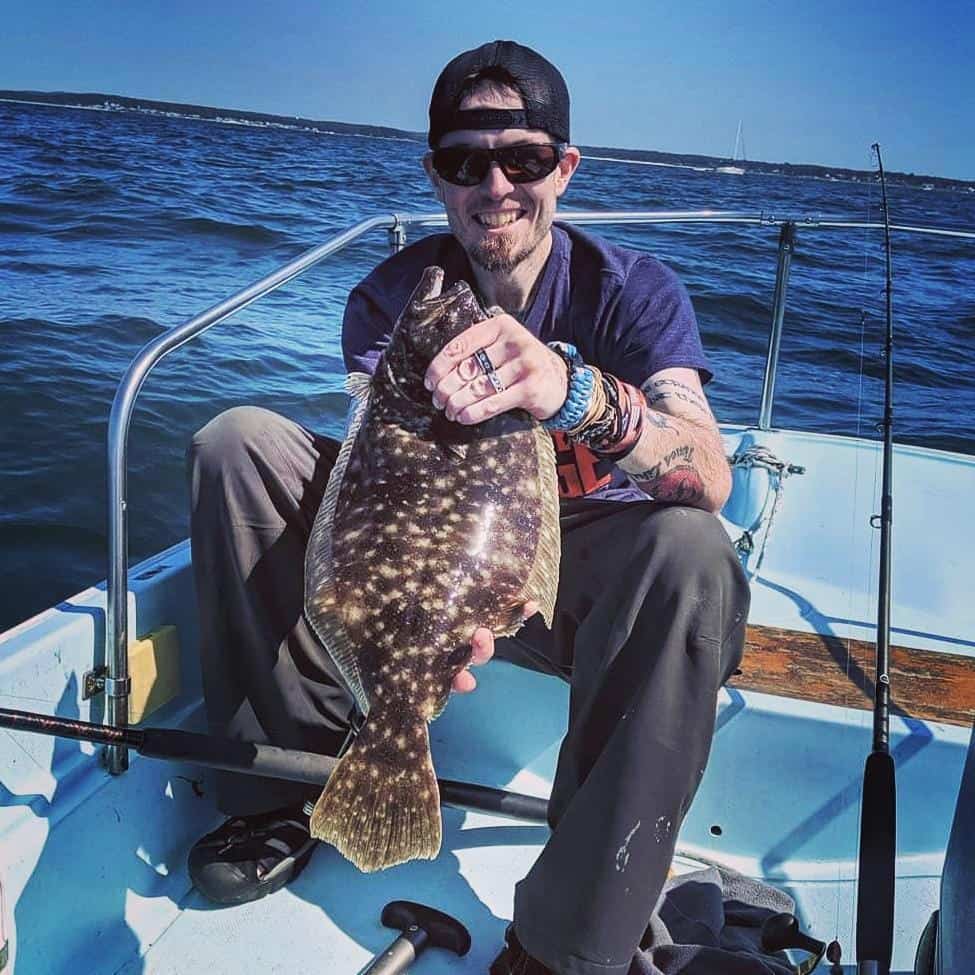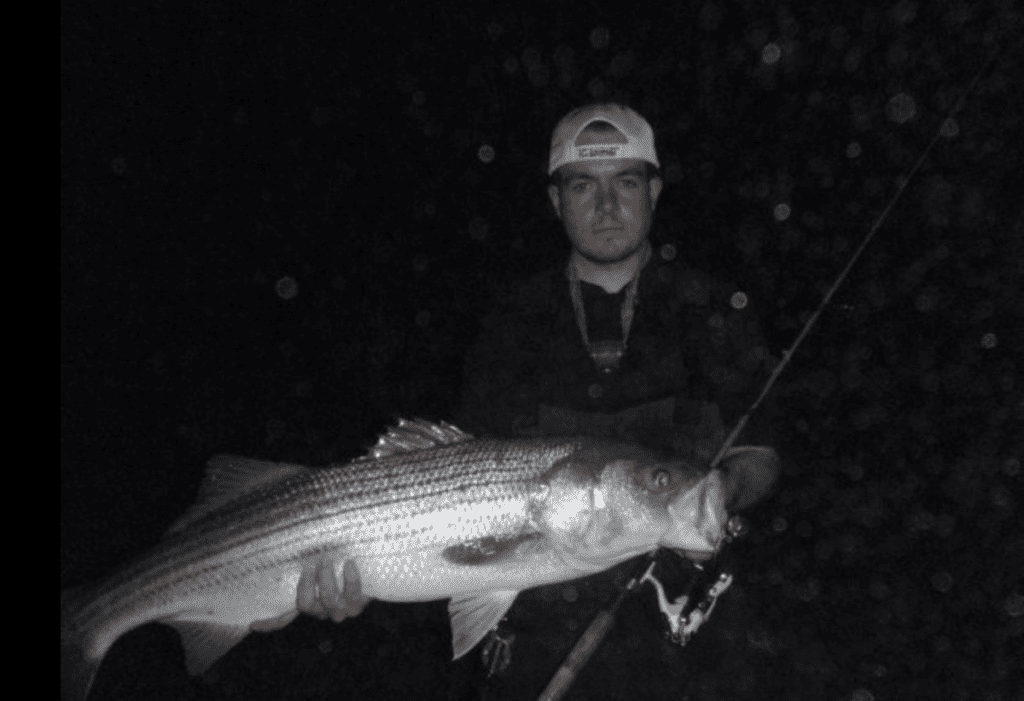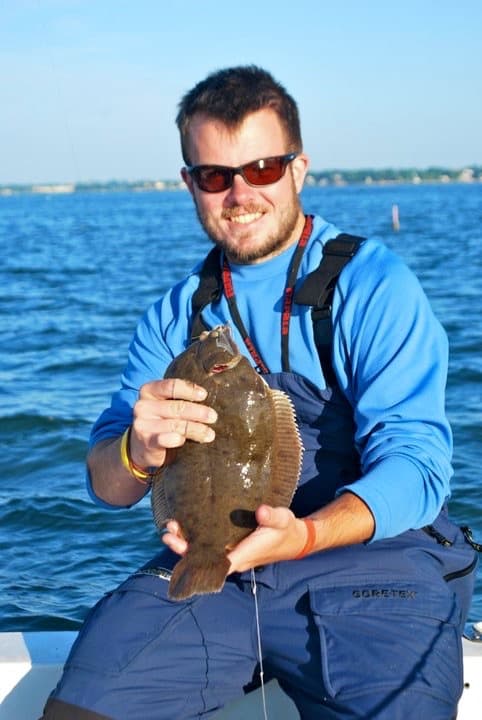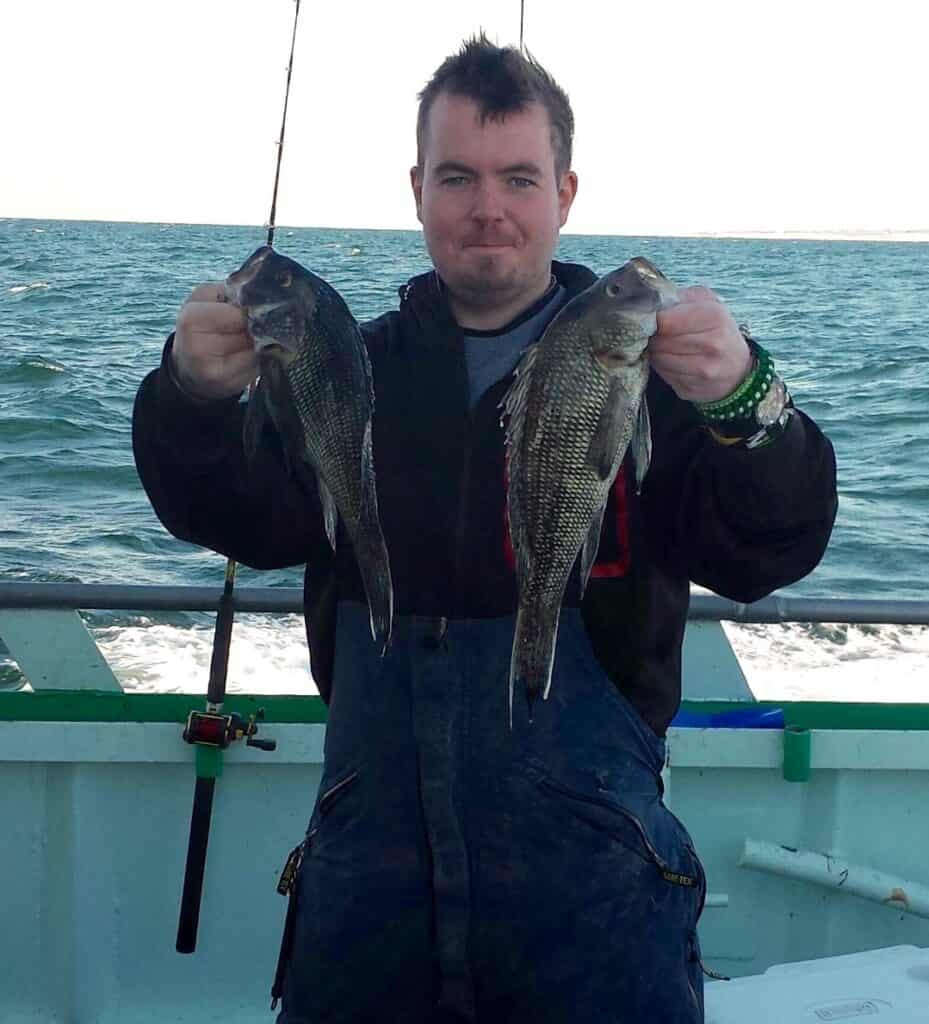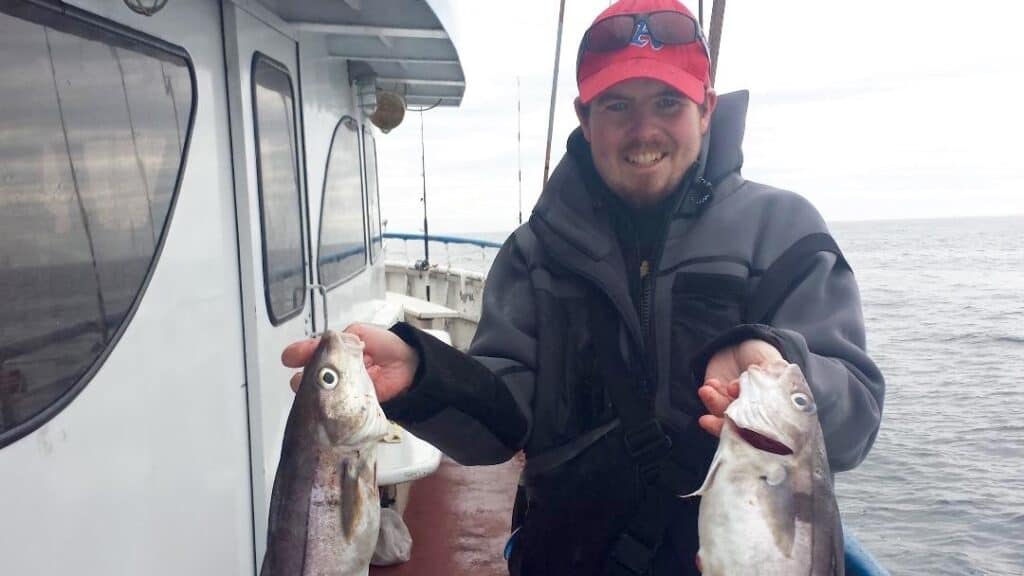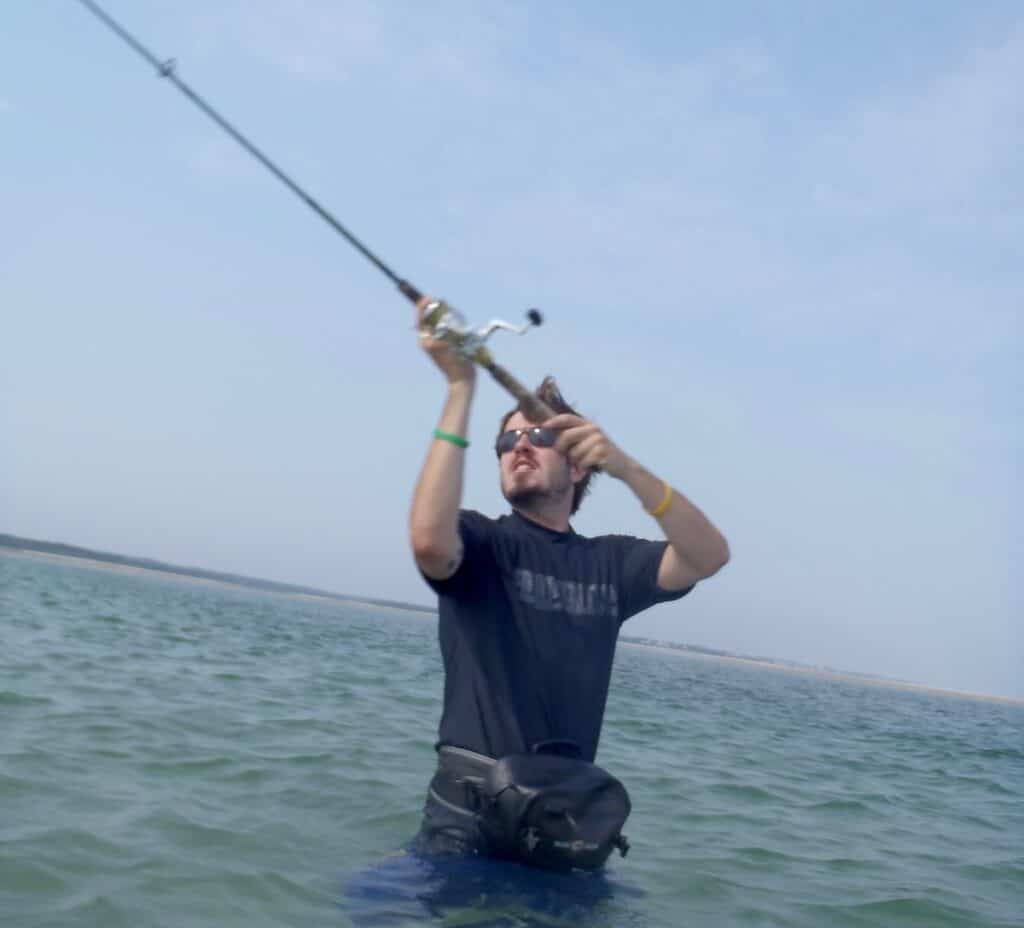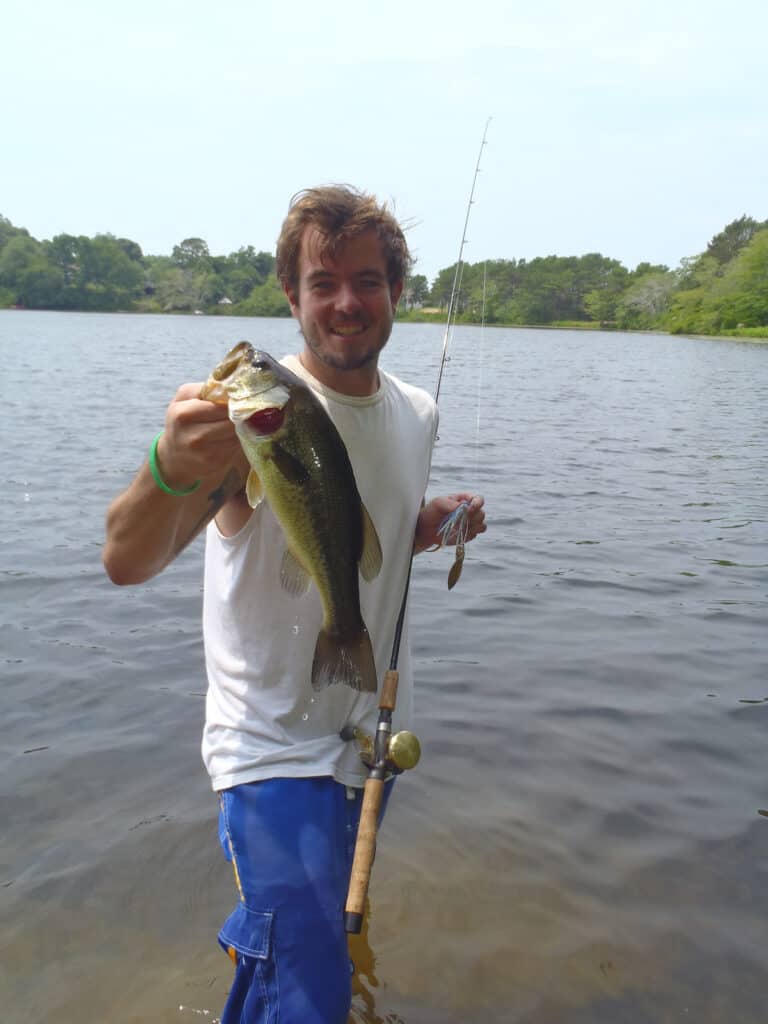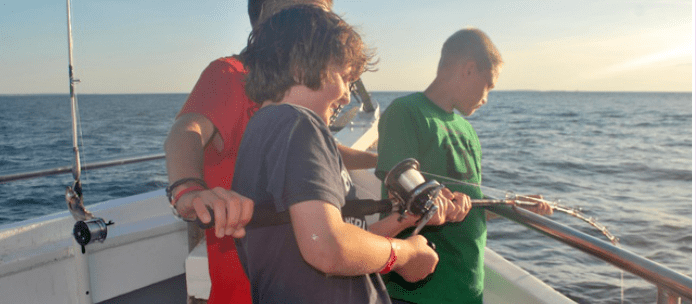No place in the Northeast is more historically known for fishing than Cape Cod, Massachusetts.
The elbow jutting out into the North Atlantic is a destination for millions of travelers, with quite a few packing their fishing gear. Cape Cod’s ponds, bays, estuaries, coastlines, and the open ocean beyond are part of the angling allure.
This complete fishing guide will help you make the most of your fishing time on the Cape. I’ve fished the Cape for years. In this article, I will show you where, when, and how to catch the most popular gamefish in one of America’s ultimate fishing spots.
If you have specific fishing experiences in mind, use the table of contents to jump to your most important topics.
Cape Cod Striped Bass Fishing
There is little doubt that striped bass are the main draw for many anglers coming to the Cape. Of course, you can target a host of species while visiting, but stripers and tuna are two of the most popular.
Because striped bass migrate every spring and fall up and down the coast, between the Chesapeake Bay and the Northeast, land masses jutting out into the Atlantic that stripers must swim around are bound to concentrate them.
What’s more, relatively shallow, nutrient-rich waters like those in Cape Cod Bay tend to hold more stripers with an abundance of forage throughout the summer.
The Cape Cod Canal that separates the mainland from the Cape itself is an extremely popular spot for striper fishing.
In the spring and fall, schools of migrating fish circumvent the long journey around the Cape’s beaches and make a straight shot through the canal.
Below this article provides detailed information about fishing in the most productive spots on the Cape. We’ll tell you how to target stripers in Cape Cod Bay, Cape Cod Canal, and salt ponds along the Cape’s coastline.
Catch More Stripers
We have plenty more detail on catching one of the Northeast’s signature sport fish, including the best surf fishing techniques and tips to catch striped bass and a separate article revealing the best striper shore fishing spots in Massachusetts.
Cape Cod Tuna Fishing
Bluefin tuna are one of the more popular offshore species that anglers fishing out of Cape Cod ports try to catch.
Their incredible fight, prized meat, and beauty make the bluefin tuna a Northeast favorite. In addition, thanks to its geographic advantage, Cape Cod ports offer a shorter run to the tuna grounds than most landings.
Experienced and well-equipped boaters can make this run on their own, but for most anglers, hiring a charter or party boat is the way to go.
Focusing on wrecks and temperature breaks with baits like rigged mackerel and ballyhoo are popular ways to target bluefin, the largest tuna on Earth.
Smaller but still sizeable yellowfin tuna and other pelagic species, from mahi to marlin, roam the deep sea with the giant tuna.
Captains will often use fishfinders near promising structure like a steep drop or a large wreck and look for big schools of bait or individual bluefin. From there, the crew will fish baits under balloons at various depths to pinpoint the tuna.
Bluefin are highly migratory fish that are always moving and chasing bait, so knowing the locations of the good structure and where fish have been found recently can make an enormous difference.
Fresh bait is essential. Mackerel, ballyhoo, butterfish, herring or bunker are all excellent options.
“Running and gunning” is a popular phrase that refers to searching an area for fish feeding on top and casting at them. Captains often start their search at a wreck or a temperature break where fish congregate.
Topwater plugs like poppers or soft-plastic baits like a Hogy can be effective when fishing this way.
It is crucial, when targeting tuna, to have gear that is up to the task. These are enormous fish, so strong hooks, braided line of least 50-pound-test, heavy-action rods, and reels capable of holding 300 yards of line are all essential.
Cape Cod Shark Fishing
South of Martha’s Vineyard and Nantucket, the Gulf Stream brings up warmer water every summer and with it a host of sharks, including thresher, blue, mako, tiger and great whites.
Although the great whites bring interest yearly for their size, rarity, and legendary animosity toward people (i.e., “Jaws”), they are federally protected. Therefore, you cannot deliberately target this species.
Thresher Sharks
This species, known for its extremely long tail (often almost the length of its body), is highly aggressive and can be caught by chumming and fishing a live-lined menhaden or a chunked bluefish. Seeing a thresher tail carve the water through a slick is a heart-pounding moment.
Mako Sharks
Makos are known for their acrobatics. They’ll jump when hooked and can reach speeds of 30 miles per hour, making them one of the hardest-fighting fish you’ll encounter. You need a special permit to keep them, but they are tremendous table fare.
Tiger Sharks
This is the largest shark you can legally target from the Cape. Tiger sharks are notorious for eating anything that swims, but bunker and bluefish are favorites as baits.
Blue Sharks
Blue sharks are the most common shark that you’ll find off Cape Cod. They travel in packs and will attack baits with abandon. Blues don’t fight as hard as other shark species (anglers have filmed videos fighting blue sharks on Barbie rods), and they’re not great table fare. As a result, anglers most often catch blue sharks while fishing for other species.
The most effective means of drawing in sharks is chumming. Having a good supply of freshly cut mackerel, bluefish, or bunker for a chum slick will bring in the sharks.
There are several ways to get the bait you’ll need for a chum slick.
If you are adept at throwing a cast net, you can find a school of bunker, which you can typically see splashing, throw a cast net and haul in a day’s worth. This maneuver can be tricky, so practicing first is recommended if you’ve never tossed a cast net.
You can also snag bunker by ripping a weighted treble hook through a school of them to procure one at a time.
A third option is using a Sabiki rig on light tackle to catch and keep mackerel for bait. Sabiki rigs have small flashy attractants that can lure multiple mackerel on a single drop into a school of them.
Fishing for Scup (a.k.a. Porgies)
Scup, frequently called porgies, are a popular food fish in New England.
Anglers can often find scup around any rock piles or other structure. They are typically shallower in the early summer months before moving to deeper water in the fall and winter.
Targeting areas between 15 and 40 feet in Nantucket and Martha’s Vineyard sounds in June, July and August is your best bet for catching porgies.
Fresh squid strips are the most popular bait for catching scup. However, if you don’t have real squid, Berkley Gulp strips can work.
Flounder and Fluke Fishing
There are both summer and winter flounder in the waters surrounding the Cape.
Winter flounder are a darker shade and are oriented in a different way in terms of their body style.
The seasons vary for each, so check the latest regulations and know the differences between species and fishing zones.
As of this writing, you can keep five fluke between May 21 and September 29.
You can keep eight winter flounder all year north of Cape Cod. However, you can only harvest two of these per day south and east of Cape Cod, and none in January or February.
Both species are ambush predators that will lie in wait and attack baitfish as they swim along the bottom. Fishing with bucktails with a trailer of either a squid strip or Gulp is your best bet.
Flounder can move as shallow as the surf in the summer. Look for soft bottom close to hard bottom or sand next to rock. They’ll lie on the perimeter of the soft bottom to ambush baitfish swimming overhead. They will often hold down-current of structure like rock piles.
Tautog Fishing
Tautog, or blackfish, are another of New England’s most popular food fish.
The most important factor when tautog fishing is this: Find rocks. Tautog are notorious for holding among rock piles and digging into them when hooked.
So, the first trick is to fish near rock piles. Then, when you hook a tautog, reel up quickly and aggressively to avoid having them pull you into the rocks.
If there’s a second element that’s almost equally important, it’s bait. Tautog love green crabs. Squid strips will work, and ‘tog are caught on artificials and jigs, but bringing fresh, live green crabs is your best bet.
Black Sea Bass Fishing
Black sea bass are very similar in their behavior to scup, and anglers often catch them in the same vicinity.
As far as food fish go, these are a great bet because you can keep a cooler full, and they’re delicious.
Sea bass prefer rock piles, steep drop-offs, humps, wrecks and ledges.
They will readily take a bucktail, especially if the lure is tipped with either squid or Gulp, and can even be caught two at a time on a hi-lo rig.
Black sea bass will move shallower in the late spring and early summer and move farther out once water temperatures become too warm.
Bluefish Fishing
Although they’re not renowned for their flavor, New Englanders will admit that bluefish are among the hardest-fighting inshore species.
Bluefish are voracious predators that surround the Cape every spring and summer and feed on menhaden, sand eels, mackerel and scup. Swimmers have been injured by blitzing bluefish.
Local lore has it that bluefish show up around Mother’s Day. That might not sound scientific, per se, but it’s usually pretty accurate.
When water temperatures inshore are warm enough to attract baitfish like sand eels and Atlantic menhaden, typically around mid-May, bluefish will come in from their offshore wintering grounds.
Fishing from the south-facing beaches on Cape Cod with squid-strip-tipped bucktails, live or chunked bait like eels, bunker, or sand eels, or any small, flashy lure can all be highly effective methods.
When schools of blitzing blues are on the beach, topwater plugs like a pencil popper can be extremely fun. Jerks of the rod tip will work a popper back and forth until a bluefish explodes on it.
Take extra care in handling and releasing bluefish, as their saliva contains an anticoagulant that will keep you bleeding if their teeth gash a finger.
Here’s a tip when working any lure through a school of feeding bluefish: Don’t stop.
Squid Fishing
One of the most enjoyable spring activities on the Cape is squidding.
Between late April and mid-May, schools of squid migrate to the Cape’s surrounding waters, providing forage for larger species.
You can procure your own calamari if you get a few squid jigs (simply baitfish imitations covered in pin-like prongs) and an ultra-light rod.
You’ll want to ensure a very light setup, as pulling the squid out of the water delicately is half the fun.
The best time to find schools of squid around lit docks or bridges is after dark.
Simply watching a YouTube video can teach you the easy method of “filleting” a squid, which involves removing its outer layer of meat (‘mantle’) and slicing it into strips.
Blue Crab Fishing
Crabbing off Cape Cod is another popular summer pastime.
Get a crab trap, which is a metal square with sides that fold down, connected to a string. When you pull the string up, it turns into an enclosed box.
Put some raw chicken in it and lower it down next to a dock or bridge in water between 5 and 15 feet deep. Periodically lift the trap to check for crabs, and measure them to ensure they’re at least 5 inches in width (diameter of shell).
You can keep 25 per day between May 16 and October 29.
Cod and Haddock Fishing
You couldn’t cover Cape Cod fishing opportunities without mentioning the species it’s named after. Cod have always been a New England favorite food fish.
Pay attention to seasonal regulations, which can change annually.
Beginning in April, you can find cod and haddock in 50 to 150 feet of water around areas like Stellwagen Bank, a marine sanctuary off the coast that is renowned for its abundant life (keep an eye out for whales).
Clams, squid and Gulp strips will all work as bait, fished on hi-lo rigs or baited bucktails. Remember that cod and haddock are both bottom feeders that will be right along the seafloor.
As of this writing, regulations were much more relaxed on haddock, meaning you’re much more likely to fill a cooler targeting them. Remember that haddock have a black stripe and cod have a white stripe, as these species often are intermixed.
Current regulations only allow one cod of at least 22 inches between April 1 and April 14 and between September 1 and October 7 north of Cape Cod. The limit is five cod between 22 and 28 inches south of Cape Cod. Always double-check for updated harvest limits and other rules before fishing.
As long as haddock are 18 inches, you can keep as many as you’d like south of Cape Cod.
Where to Fish on Cape Cod
The following are some of your best bets for different types of fishing experiences on Cape Cod.
Cape Cod Shore Fishing
You’ve got a few different options when shore fishing from Cape Cod. Let’s take a look at some of the best.
Fishing Cape Cod Canal
Fishing the Cape Cod Canal can be a challenging learning experience but it can also make for some of the most fantastic striper blitzes you’ll ever see.
The canal features rocky bottom and shoreline and swift currents compared to the surrounding water because, in essence, water is pouring in and out of Cape Cod Bay. The current can rip as fast as four knots on a big tide.
It can be necessary to throw lures as heavy as five ounces to hold the bottom.
A large soft-plastic bait like a Hogy fished on a jighead, a larger bucktail, or a topwater plug are all popular canal options when targeting striped bass.
Topwater plugs like a Cotton Cordell Pencil Popper or a Superstrike Little Neck Popper are great choices when blitzing fish are pushing bait to the surface, most common at first light.
You will hear anglers talk about “breaking tides” when they’re discussing fishing the canal. Breaking tides occur when the current changes from west to east right around sunrise, a great time for topwater fishing.
Anglers also catch bluefish and flounder in the canal.
For targeting fluke or flounder, a lighter setup is usually ideal. The advantage is that you will feel more subtle hits and set the hook without ripping the lips off these smaller fish.
Fishfinder rigs with clams, squid or Gulp are good bait options for flatfish. Slack tide will be your best opportunity to catch flounder in the canal.
Bluefish will chase Hopkins spoons, topwater plugs, bucktails, or Hogy soft-plastic baits, fished on top or a jighead.
Cape Cod Bay Fishing
Targeting stripers in Cape Cod Bay can be phenomenal in the late spring and early summer months when schools of fish arrive and set up in their typical feeding patterns.
Find structure like sand bars, drop-offs, or any abrupt change in bottom contour that will allow striped bass and bluefish to corral bait in shallow water or near submerged structure.
Studying topographical maps of the bay can be a promising way to find structure and stripers. Remember that new and full moons will produce the strongest tides.
The flats in Brewster, covered next, are an excellent example of the type of bay structure you can target from a boat as well as on foot.
Fishing the Brewster Flats
The flats near Brewster offer land-based fishing with shots at stripers, bluefish, fluke and flounder.
Off Saints Landing Beach in Brewster, an extensive tidal flat becomes dry at low tide. Anglers can walk out on this tidal flat for half a mile before reaching a channel that flows out into Cape Cod Bay.
These gamefish will position themselves in and around this channel because it is a prime location to intercept bait going back and forth between the beach and the bay.
The last two hours of an outgoing tide and the first hour of an incoming tide offer water low enough to fish the channel on foot.
A seven-and-a-half-foot medium-heavy spinning rod with a 4000-sized spinning reel filled with a 30-pound-test braid and a 14-pound-test fluorocarbon leader is an excellent setup for fishing the flats.
Soft-plastic jerkbaits like Slug-Gos and Hogys, as well as bucktails and Bombers, can all be effective on the flats.
I’ve caught stripers as large as 17 pounds on the flats on what, for stripers, amounts to ultra-light gear: a 7.5-foot medium spinning rod, 4000-sized reel, and 20-pound-test braided line. That fish hit a pink Slug-Go at dawn, but bait is typically your best option on the flats.
It’s essential to be aware of the incoming tide. These flats flood at high tide at a relatively fast clip. A fanny-pack-style inflatable PFD is a great idea.
Fishing the Cape’s Salt Ponds
On the southwest corner of Cape Cod, a series of salt ponds often hold schools of fish, particularly in the spring. On a map, look for finger-like cuts into the south side of the Cape.
Striped bass will push schools of bait into these ponds and feed voraciously, particularly after dark in May and June.
The element I’ve found incredible about this fishery, for a shore-based angler, is that you are fishing for stripers that push 20 pounds, yet you can do it with relatively light gear because you’re not casting heavy lures over a surf break.
Here you’re fishing in what is very much like a pond.
Target these salt ponds at the beginning of the migration, particularly on nights with larger tides (new moons).
Use soft-plastic baits like Hogys or Slug-Gos or stickbaits like Rebels or Bombers with saltwater-grade hooks.
The largest striped bass I ever caught on foot came in a Cape salt pond in May. It took a Slug-Go fished weightlessly as a topwater lure.
Jimmy Fee and I caught numerous stripers in a single May night that weighed as much as 20 pounds, and larger fish are caught from shore on the Cape all the time.
Cape Cod Deep Sea Fishing
For anglers looking for a more reliable way to fill a cooler and enjoy a day on the water, consider a headboat trip on a boat like the Helen H out of Hyannis.
Party boats offer various options depending on how much money and time anglers want to spend. Anglers that simply want a short, fun trip and some fresh filets for the grill can take a six-hour trip for about $100 and reel up porgies.
Twelve-hour trips give anglers a shot at fishing grounds farther from the port, and more of a mixed bag in terms of species, with fluke, cod and haddock typically coming over the rails.
If you enjoy this type of fishing regularly, invest in a six-and-half-foot, medium-heavy conventional setup capable of holding at least 300 yards of 15-pound-test monofilament.
Having a familiar setup can give you an advantage over anglers using rental rods.
Trips targeting tuna, wahoo, mahi and swordfish can be as long as 32 hours and head to undersea canyons far offshore, where anglers have a better shot at these pelagic species. These long fishing tours range from between $500 and $1,000 per angler.
Hy-line Cruises is another charter company that offers a headboat experience out of Hyannis, targeting sea bass, scup and flounder around Martha’s Vineyard Sound.
Cape Cod Fishing Charters
Headboats, or party boats, take larger groups and can be a great option for newcomers to fishing.
However, consider hiring a private charter if you’re serious about targeting larger fish, especially on light tackle.
The following are some of the charter captains I recommend after fishing the Cape for years.
Captain Eric Staplefield makes his own bucktail jigs and typically runs Hairball Charters out of Falmouth on Cape Cod, but he’ll tow the boat to you if you’re elsewhere on the Cape.
Captain Bobby Rice runs Reel Deal Charters out of Truro and targets striped bass, bluefish and tuna. This company is a great option for anglers on the outer Cape.
Captain Ross of the Cape Cod Charter Guys runs trips out of Bourne and is another great option for targeting striped bass, bluefish, black sea bass and tautog.
Captain Terry Nugent of Riptide Charters has been fishing Cape Cod and the surrounding waters for years and can give anglers an excellent light-tackle experience for stripers, bluefish, and all manner of inshore game fish.
Cape Cod Freshwater Fishing
The freshwater fishing on Cape Cod can be phenomenal and is often overlooked, with so many anglers targeting saltwater species.
The following are three of my favorite spots:
Nickerson State Park
Nickerson State Park in Brewster offers some of the best freshwater fishing in Massachusetts.
Both Cliff and Little Cliff ponds in the park are stocked generously with hatchery trout, often in both spring and fall.
Nickerson is a great place to wet a line, and Cliff Pond made our complete guide to the best trout fishing lakes and rivers in Massachusetts.
Long Pond
Long Pond in Brewster is one of the largest ponds on the Cape and offers anglers good shots at decent-sized smallmouth and largemouth bass.
Long Pond also is another Cape Cod lake seasonally planted with hatchery trout. (See the full list below under Trout Fishing.)
Long Pond has good access from Route 124.
Black Pond
Here’s a recommendation you likely won’t find elsewhere. It isn’t easy even to find Black Pond on maps, but it’s just west of Long Pond. This small pond is rarely fished and access can be tough.
But I can vouch for it because it’s where I’ve caught better-than-averaged sized largemouth bass and had the place to myself. For the underwhelming size of the pond, it has good populations of healthy largemouth bass and pickerel.
To get there, use a land bridge between Long Pond and Black Pond (you can haul a kayak the short distance) or more limited access from Crowells Bog Road.
Trout Fishing on Cape Cod
If you’re into trout fishing, Cape Cod has plenty of it.
While there is some history of sea-run trout here, most of the easiest action here comes courtesy of trout that are hatchery raised and arrive in trucks during the cooler seasons.
The Massachusetts Division of Fisheries and Wildlife (DFW) generously stocks these hatchery trout for anglers to catch in many of the Cape’s more accessible ponds during the spring as early as March. DFW also stocks select waters once the weather cools in the fall, often around late September or early October.
Fishing for stocked trout in lakes and ponds tends to be excellent in the days and few weeks after a stocking and then slow as anglers catch out the fish or the water temperatures get too warm or cold.
Stocked trout readily bite on baits ranging from worms to PowerBait. Casting artificial lures or flies also can provoke these aggressive fish to strike.
Check out our complete guide to trout fishing techniques for all the tips you’ll need to catch these fish.
The following is a complete list of Cape Cod ponds and other waters that typically receive stocked trout, organized by the nearest city or town to help you quickly find a great fishing spot.
Stocked Trout Ponds and Creeks
DFW typically stocks all the ponds listed below for the spring season. Ponds marked with an asterisk (*) may be re-stocked with trout in the fall.
Barnstable: Hamblin Pond*, Hathaway Pond, Lovells Pond and Shubael Pond*
Brewster: Cliff Pond*, Flax Pond*, Higgins Pond, Little Cliff Pond* and Sheep Pond*
Chatham: Goose Pond and Schoolhouse Pond
Dennis: Scargo Lake*
Eastham: Herring Pond*
Falmouth: Ashumet Pond*, Deep Pond, Grews Pond* and Mares Pond
Mashpee: Ashumet Pond*, Johns Pond* and Mashpee/Wakeby Ponds*
Orleans: Baker Pond* and Crystal Lake*
Sandwich: Peters Pond*, Pimlico Pond, Scorton Creek and Spectacle Pond*
Truro: Great Pond
Wellfleet: Gull Pond
Yarmouth: Long Pond
Cape Cod Kids and Family Fishing
You have some great options for fishing with children on Cape Cod.
For freshwater anglers, the ponds in Nickerson State Park mentioned previously offer easy access, a quiet, stress-free atmosphere, and great trails for hiking.
All the ponds and lakes listed in the trout stocking section above also will be good choices and may provide enough action to keep kids engaged in the spring and often again in early fall. Some also will have summertime action for bass and panfish.
If saltwater fishing is your goal, the headboats mentioned in the party boat section are an excellent introduction to ocean angling for families with children.
These large boats can provide a moderately priced trip on the water for families looking to get kids on their first saltwater fish.
Kids will see a variety of fish caught, get the chance to bend a rod and learn about the species they’re targeting from friendly mates.
Fly Fishing on Cape Cod
Fly fishing on Cape Cod can be a way to add a little bit of an extra challenge to your outing. On ponds like those in Nickerson State Park, you’ve got a chance at casting topwater flies, and streamers to smallmouth bass and trout.
Cliff, Flax and Little Cliff ponds will all offer fly rodders a shot at fish from shore or a kayak during low-light periods.
In saltwater, fly fishing can be especially popular for species like false albacore and bonito that are feeding on sand eels in the months of August and September.
You’ll need a bit of luck to find them feeding close enough to shore to get a fly in front of them, but a kayak and a fly rod can be a great option for these bullet-fast fish in the late summer and early fall.
Kayak Fishing
Kayak fishing can be a popular way to get at stripers out of reach for surfcasters.
If you’ve got a calm weather window, Kayaking Cape Cod Bay can make for an amazing light-tackle fishing experience.
Medium rods between 6.5 and 8 feet, compatible reels, and 20-to-30-pound-test braided line with a fluorocarbon leader are good kayak options.
Bring an assortment of lures, including topwater soft-plastic baits, bucktails, and minnow plugs, and work the areas around drop-offs, sand bars, cuts and rips.
Best Times for Cape Cod Fishing
Spring
In the months of April and May, Cape Cod fishermen will see the first schoolie stripers show up along the coast. Bluefish will crash the party in May.
The Massachusetts Department of Fish and Wildlife will stock Cape Cod ponds with trout around the first of April.
Party boats targeting cod, haddock, pollock and fluke are also popular spring options.
Be sure to mark the May and June new and full moons on your calendar. New and full moons coincide with the biggest tides, meaning you’ll have the most water, moving the fastest, over and around structure, which will concentrate schools of feeding fish.
Summer
As June gives way to July, stripers will begin feeding in shallower water only at first and last light, and finally only after dark once water temperatures climb.
Fluke and flounder will become much more abundant in Cape Cod Bay and Martha’s Vineyard Sound.
June and July can be great months for bottom fishing for black sea bass, scup and tautog.
Anglers will begin making long runs to the Canyons to target tuna, mahi and wahoo.
Fall
In the fall, schools of stripers pour down the coast, pushing bait into shallower water in Cape Cod Bay, Martha’s Vineyard Sound, Cape Cod Canal, Chatham, and on nearby Monomoy Island.
Albies and bonito will show up in force in late August and September. Tuna fishing can be fantastic in the Canyons in October and November.
Winter
While many types of fishing slow during the coldest months, hardy saltwater fishermen will keep targeting haddock and pollock on the offshore grounds as conditions allow.
Cape Cod Fishing Reports
If you’re looking to see what’s biting on the Cape, check out the Facebook pages of some of the regular working charter captains and party boats that run every day.
Here are some regular sources of updated Cape Cod fishing reports:

